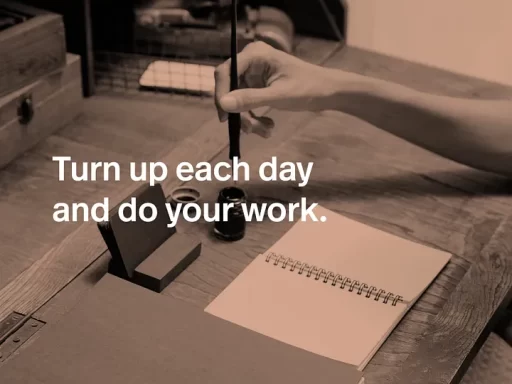Have you ever looked at the clock, willing the hands to move slower, just to give yourself a few more precious minutes? Or maybe you’ve stared at a looming deadline, paralyzed by the urge to tackle anything else under the sun? If so, then you, my friend, are well acquainted with the ever-present struggle of procrastination.
For the longest time, I was locked in a constant battle with time. It felt like an enemy, always one step ahead, leaving me perpetually playing catch-up. But here’s the thing: the problem wasn’t time itself; it was my relationship with it.
Let me tell you my story, a story of how I went from being a slave to procrastination to finally making peace with time.
The Scrolling Monster and the Banished Clock
It all started with a simple nighttime habit: scrolling through my phone until my eyelids grew heavy. I knew it wasn’t good for me, but the allure of the endless scroll was just too strong. To break this cycle, I decided to banish the culprit from my bedroom. But there was a catch: my phone also served as my alarm clock. Enter the hero (or maybe the villain?) of this story: a traditional alarm clock.
This seemingly small purchase was a big deal. You see, for years, I had avoided clocks in my home. Why? Because they were a constant reminder of the time, my supposed enemy. Every tick of the second hand felt like a judgment, a reminder of all the things I wasn’t getting done.
Looking back, I realize how extreme this may seem. But for someone who constantly procrastinated, running behind schedule, and feeling the pressure of deadlines, even a clock felt like a source of stress.
Beyond Time Management: The Roots of Procrastination
While I knew procrastination was holding me back, I never considered it a “psychological issue.” That perspective changed dramatically when I stumbled upon a book titled “Procrastination: Why You Do It, What To Do About It Now” by Jane Burka and Lenora Yuen.
These authors, themselves reformed procrastinators, opened my eyes to a whole new world. They argued that procrastination wasn’t just about poor time management; it was rooted in deeper emotional issues, like the fear of failure.
The book explained that many procrastinators, like myself, associate their self-worth with their achievements. We believe that if we don’t perform perfectly, it means we are failures as individuals. This fear can be so paralyzing that we end up delaying tasks altogether, protecting ourselves from the potential disappointment of not meeting our own (often unrealistic) expectations.
The Equation That Ruled My Life
The book also introduced me to an equation that resonated deeply with me: Self-worth = Ability = Performance. This equation, formed in my childhood, had become a core belief. I saw my academic and professional achievements as the sole measure of my self-worth.
Excelling at school was my way of standing out, earning praise, and feeling valuable. This need to succeed wasn’t just about external validation; it was tied to my very sense of self.
By delaying tasks, I was subconsciously trying to avoid the possibility of my performance falling short, which in my mind, meant I would fall short as a person. This fear, however, was keeping me stuck in a cycle of self-doubt and procrastination.
The Illusion of Control: Why We Procrastinate Time Itself
But my issues with time went beyond fearing failure. The book also shed light on how I struggled to tell time “effectively.” It turns out, there are two types of time: objective time, measured by clocks and calendars, and subjective time, our personal experience of time’s passage.
For many procrastinators, there’s a disconnect between these two. We might underestimate how long tasks take or be oblivious to how quickly time actually flies by. This can lead to a distorted sense of control, where we believe we can stretch or manipulate time to our will.
Procrastination, in this sense, becomes a way of asserting dominance over time, even if it’s an illusion. We might convince ourselves we can “do things our own way on our own schedule,” feeling empowered even as deadlines loom closer.
Understanding My Procrastination Patterns
Armed with this newfound knowledge, I was finally ready to tackle my procrastination head-on. The book suggested creating a “procrastination inventory” to understand my personal delaying tactics and triggers.
Filling out this inventory was an eye-opening experience. I identified my main areas of procrastination (work projects and personal passions) and my go-to tactics (cleaning, working on less important tasks). My excuses? The usual suspects: “It’s too late to start this week,” or “I My excuses? The usual suspects: “It’s too late to start this week,” or “I need a break.”
The book also encouraged me to track my excuses and observe my thoughts leading up to procrastination. This simple exercise revealed a pattern: whenever I felt overwhelmed or unsure about a task, the urge to procrastinate would hit me like a ton of bricks.
The Experiment: Taking Action One Step at a Time
The book then presented a practical approach to overcoming procrastination: setting a behavioral goal. This goal needed to be specific, achievable, and broken down into small, actionable steps. It also had to be something I could realistically accomplish within five minutes.
The book outlined a series of steps to follow:
- Write down the goal: Clearly define your goal and break it down into manageable steps.
- Seek feedback: Share your plan with someone and ask for feedback.
- Visualize success: Imagine yourself completing each step of the goal.
- Start, regardless of feelings: Don’t wait for motivation; begin even if you don’t feel like it.
- Set a time limit: Allocate a specific time frame for each step.
These steps might sound simple, but putting them into practice was a challenge. My inner critic kept whispering doubts, and procrastination offered its familiar, albeit unhelpful, comfort zone.
However, I persisted. I chose my first goal: completing an application for a writer development program with a magazine. I broke it down into bite-sized steps, like gathering information, writing the essay, and proofreading. I set realistic time limits and, most importantly, I started, even when the urge to procrastinate was strong.
Following Through: The Power of Small Wins
The book also provided valuable advice on following through:
- Be aware of excuses: Recognize your typical excuses and challenge their validity.
- Focus on one step at a time: Don’t get overwhelmed by the entire goal; focus on completing the current step.
- Work around obstacles: Expect interruptions and distractions, and have a plan to deal with them.
- Reward yourself: Celebrate your progress, no matter how small.
- Be flexible: If your goal needs adjustments, don’t be afraid to adapt.
- Embrace imperfection: Don’t strive for perfection; focus on making progress.
Following these guidelines, I managed to chip away at my goal, one step at a time. Each completed step, no matter how small, felt like a victory. I even started using the book’s “un-schedule,” a weekly calendar to track my activities and commitments. This helped me visualize my time more effectively and identify pockets where I could work on my goal.
Learning to Live With Time, Not Against It
The un-schedule also revealed some unexpected truths. First, I learned to be more realistic about how long tasks actually take. Second, I discovered the power of “micro-productivity,” utilizing small pockets of time throughout the day to make progress.
Most importantly, I learned to accept the limitations of time. Time is not something I can control, but it’s something I can learn to live with. I embraced the concept of “prime times,” recognizing that my focus and energy levels fluctuate throughout the day.
Finally, I started prioritizing leisure time. Neglecting this crucial aspect of my life had only fueled my procrastination further. By allowing myself to relax and recharge, I found I had more energy and focus to tackle my goals.
The Outcome: A New Chapter
My initial goal, completing the application for the writer development program, was just the beginning. The program itself proved to be a life-changing experience, opening doors and opportunities I wouldn’t have imagined possible.
But the most significant takeaway from this journey was the newfound peace I made with time. I learned to challenge my limiting beliefs, identify my procrastination triggers, and set achievable goals.
More importantly, I learned to see time not as an enemy, but as a valuable resource to be managed, not controlled.
A Message of Hope for Fellow Procrastinators
If you, like I once was, are struggling with procrastination, I want to leave you with a message of hope. Change is possible. By understanding your triggers, setting realistic goals, and taking action one step at a time, you can overcome procrastination and reclaim control of your time.
Remember, you are not alone in this battle. There are countless resources available, and the first step is simply acknowledging the desire to change. So, take a deep breath, silence your inner critic, and start your journey towards a more productive and fulfilling life.
Have you ever struggled with procrastination? What strategies have you found helpful?
I’d love to hear your thoughts and experiences in the comments below. Perhaps by sharing our struggles and successes, we can help each other on this journey towards a more mindful and productive relationship with time.
Additional Tips for Beating Procrastination:
- Identify your rewards: What motivates you? Completing tasks can be its own reward, but sometimes, external motivators can be helpful. Identify what works for you, whether it’s a relaxing evening after completing a task or a small treat for reaching a milestone.
- Practice self-compassion: Be kind to yourself throughout this process. Change takes time, and there will be setbacks. Don’t beat yourself up if you slip back into old patterns; simply acknowledge it and recommit to your goals.
- Find an accountability buddy: Share your goals and progress with a friend, family member, or even an online community. Having someone to support and hold you accountable can be a powerful motivator.
- Break down large tasks into smaller, more manageable chunks: Feeling overwhelmed by a large project is a common trigger for procrastination. Break the project down into smaller, more achievable steps, and tackle them one at a time.
- Experiment with different techniques: Find what works best for you. There are many different productivity techniques out there, such as the Pomodoro Technique or the Eisenhower Matrix. Experiment with different methods and see what helps you stay focused and motivated.
- Seek professional help if needed: If you’re struggling to overcome procrastination on your own, consider seeking professional help from a therapist or counselor. They can provide personalized guidance and support to help you identify the root causes of your procrastination and develop effective coping mechanisms.
Remember, overcoming procrastination is a journey, not a destination. By embracing self-awareness, taking action, and being kind to yourself, you can develop a healthier relationship with time and achieve your goals.







